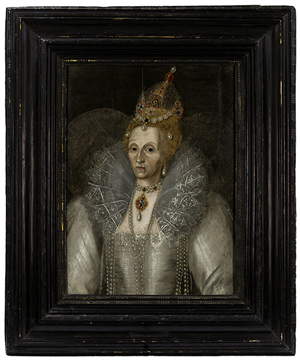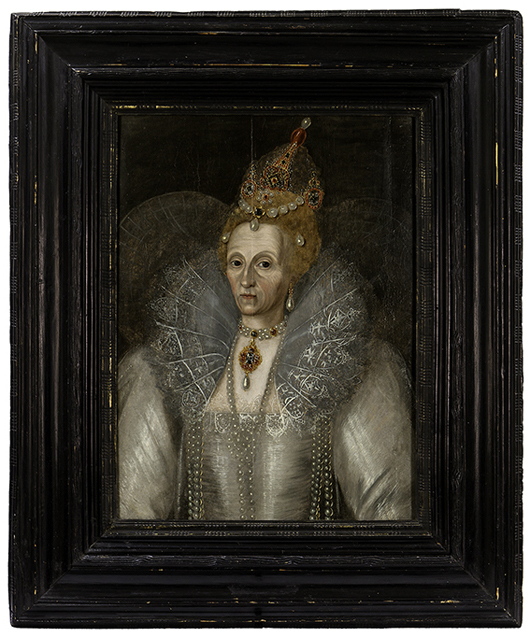
RALEIGH, N.C. (AP) – For decades, a portrait of Queen Elizabeth I hung in a small garden gift shop on North Carolina’s Outer Banks. Legend had it that the piece was rare – it depicted the monarch as an old woman – but some art experts disagreed.
That all changed in 2010, when East Carolina University’s conservator analyzed the portrait and dated it to 1592, when Elizabeth would have been about 60 years old.
Now, the portrait has made its way to Washington, D.C., for its first exhibit since benefactor Ruth Coltrane Cannon donated it to the Elizabethan Gardens in the 1950s.
All the attention has Carl Curnutte, the gardens’ executive director, considering the portrait in a whole new light.
“The gardens respected it just as we respect all of our furnishings,” he said. “It was just seen as a part of the whole facility. And now it’s totally different. I react to it differently.”
The oil-on-oak painting is part of “Nobility and Newcomers in Renaissance Ireland” at the Folger Shakespeare Library. The artist is unknown, but the painting has long been attributed to the school of Marcus Gheeraerts the Younger, an artist of the Tudor court.
It is one of maybe just two large portraits that show Elizabeth as an older woman, said Anna Riehl Bertolet, author of The Face of Queenship: Early Modern Representations of Elizabeth I. The other is in the Burghley House Collection in England and also is attributed to Marcus Gheeraerts the Younger.
Bertolet said Elizabeth protected her image not because of vanity, but because a painting of an aging queen could undermine her power and worry her subjects since she had no husband, no children and no named successor.
“So she really didn’t perpetuate the image of a very realistic Elizabeth,” said Bertolet, an associate professor of English at Auburn University.
But in the portrait from North Carolina, Bertolet said, Elizabeth “looks very calm and philosophical. She’s old, but she owns it. She doesn’t look like she’s embarrassed at being old. She’s a woman in power who has aged.”
Cannon bought the portrait from a New York City art gallery. Once it was placed at the Elizabethan Gardens, board Chairwoman Marie Odom tried at least a few times to determine its value, her daughter remembered. Odom was president of the North Carolina Garden Club, which founded the period gardens as a memorial to the area’s colonists.
“She thought it was valuable, and they told her it wasn’t,” Lisa Odom said of her mother, who died in 2003. “Bless her heart. … I think she would be thrilled. She gave her soul to that garden.”
The portrait eventually made its way from the gardens to the walls of the Folger through the work of two ECU teachers: history professor Larry Tise, and Thomas Herron, associate professor of English and co-curator of the Folger show.
When Tise was director of the state Office of Archives and History, he visited the gardens often. Each time, he would ask about the portrait and get the same answer: It was from the 16th century and it was hanging there because that’s where Mrs. Cannon wanted it.
He left North Carolina in the early 1980s and returned in the late 1990s. “And there was that danged portrait in the gift shop,” he said.
Eventually, ECU hired a conservator, who studied the portrait in 2010 and concluded it really was painted in the late 16th century. “By this point, it had so much interest, it had to go into a vault,” Tise said.
Enter Herron, who wanted to include a portrait of Elizabeth in the Folger exhibition because she ruled Ireland. The Elizabethan Gardens’ portrait was a good choice – likely to attract attention because most people didn’t know it existed, he said.
“Everybody’s got this Antiques Roadshow mindset so if you find something like that, it’s kind of neat,” he said.
The portrait is the subject of an episode of CNBC’s Treasure Detectives. On the show, a team helps collectors learn more about the authenticity of their pieces. Curnutte said it should air in March or April, and he hopes to learn more about the painting – who painted it, how much it’s worth – from the show.
“It’s part of our history, part of the history of the gardens, part of Mrs. Cannon’s legacy,” he said. “For me, the toughest question is going to be, if it’s worth something, parting with it. If it’s worth a lot of money, can the gardens keep up with it, insure it, keep it in a safe place? The gardens are not designed to take care of a picture of that worth.”
___
Online:
http://elizabethangardens.org/
http://www.folger.edu/
___
Martha Waggoner can be reached at http://twitter.com/mjwaggonernc.
Copyright 2013 Associated Press. All rights reserved. This material may not be published, broadcast, rewritten, or redistributed.
AP-WF-03-02-13 1608GMT
ADDITIONAL IMAGES OF NOTE



